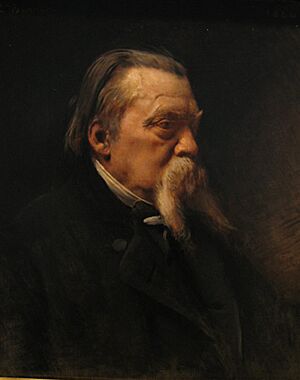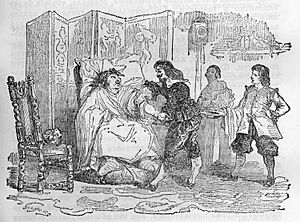Jean Gigoux facts for kids
Jean François Gigoux (born January 6, 1806, in Besançon – died December 11, 1894, in Paris) was a talented French artist. He was a painter, a lithographer (someone who makes prints using a special stone or metal plate), an illustrator, and also a collector of art.
A Young Artist's Journey
Jean Gigoux's father, Claude Étienne Gigoux, was a blacksmith. Jean started his art studies at the local art school in Besançon. Later, in 1828, he moved to Paris to study at the famous École des Beaux-Arts. There, he learned from well-known artists like Théodore Géricault and Jean-Baptiste-Camille Corot. These teachers even helped him pay for a trip to Italy, which was very important for artists to learn from the old masters.
In 1831, Jean Gigoux showed his artwork for the first time at the Salon, which was a very important art exhibition in Paris.
Becoming Famous
Jean Gigoux started contributing to a magazine called Le Magasin pittoresque in 1833. Just two years later, he became very well known for his work on a book called Gil Blas by Alain-René Lesage. He created hundreds of woodcuts for this book. Woodcuts are a type of print made by carving an image into a block of wood. This work made him very famous.
In 1842, Jean Gigoux was honored with the title of Chevalier in the Legion of Honour. This is a very high award given by the French government for excellent service to France. Many of his students also became famous artists, including Henri Baron, Léopold Flameng, and François-Louis Français.
His Legacy
Jean Gigoux passed away in Paris in 1894. He left a huge collection of his art to the Musée des Beaux-Arts et d'Archéologie de Besançon. This gift included more than 3,000 drawings and 460 paintings! Because of his generosity, he is remembered as one of the most important donors to that museum. There is even a monument at his grave in the Champs-Bruley cemetery in Besançon.
His artwork has been shown in special exhibitions, like one at the Musée des beaux-arts de Rouen in 2007–2008. You can also see his paintings and drawings in other museums, such as the Musée des Beaux-Arts de Rouen, the Musée des beaux-arts de Chambéry, Musée Magnin, and the famous Louvre Museum.
See also
 In Spanish: Jean Gigoux para niños
In Spanish: Jean Gigoux para niños



